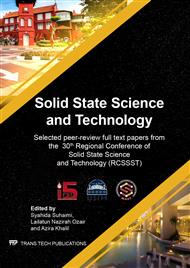p.125
p.131
p.136
p.143
p.149
p.154
p.160
p.166
p.171
Lattice Expansion of BaCe0.54Zr0.36Y0.1O3-δ Ceramic Electrolyte
Abstract:
Abstract. Solid oxide fuel cell (SOFC) is an electrochemical conversion device that undergoes a thermal cycling at various operating temperature where lead to the degradation of its mechanical properties. Electrolyte among the main component in SOFC plays a crucial part in defined the overall performance which facing a lattice expansion event when exposed to heating. Thus, in this paper BaCe0.54Zr0.36Y0.1O3-δ (BCZY) was selected as potential electrolyte for intermediate temperature solid oxide fuel cell (IT-SOFC) to investigate its lattice expansion as a function of temperature. The sample was prepared via a sol gel method and calcined at 1100°C for 10 hours to form a powder and then pressed to become a pellet. To ensure a good densification in such pellet, two-steps sintering processes was indicated at 1500°C and ground to a powder form prior to the lattice expansion measurements. High temperature X-ray diffraction (HT-XRD) was used to study the lattice expansion of sample in the temperature range of 25°C to 700°C with interval 100°C under air atmosphere. HT-XRD analysis was done using X’pert Highscore Plus software and Visual for Electronic and Structural Analysis (VESTA) software was used to observe the crystal structure. Phase and structural analysis of BCZY electrolyte materials were discussed. Apparently, the BCZY shows an average of 97% phase purity from room temperature to 700°C. Rietveld refinement analysis revealed that the BaCe0.54Zr0.36Y0.1O3-δ exhibits cubic symmetrical structure with unit cell, a=b=c that varied from 4.3440Å - 4.3731Å for all the temperature studied. Thus, the expansion percentage for the lattice expansion from room temperature to 700°C was about 12.6 %.
Info:
Periodical:
Pages:
149-153
Citation:
Online since:
July 2020
Keywords:
Price:
Сopyright:
© 2020 Trans Tech Publications Ltd. All Rights Reserved
Share:
Citation:


